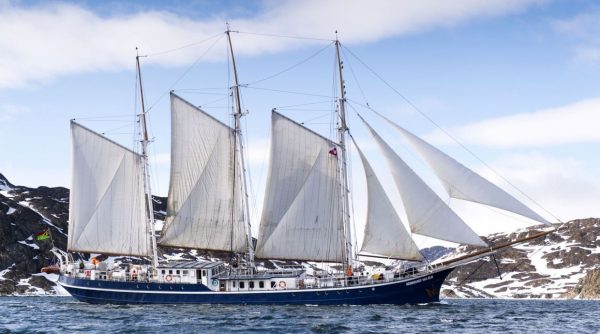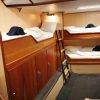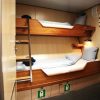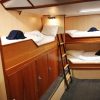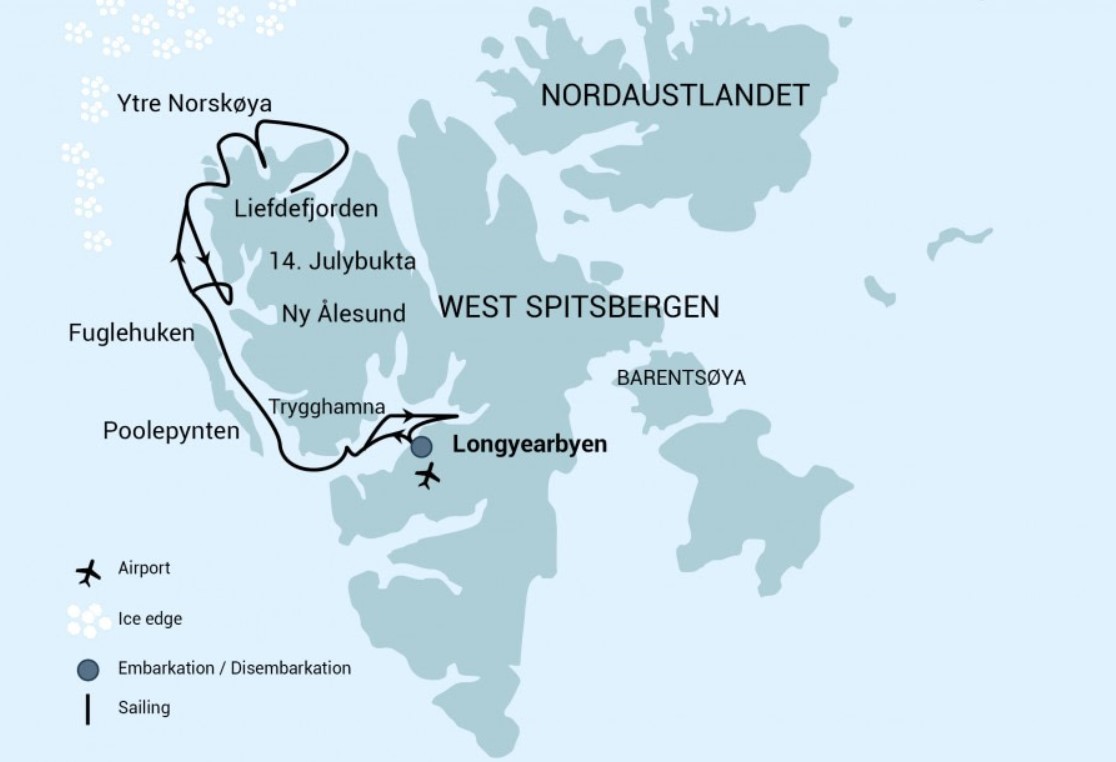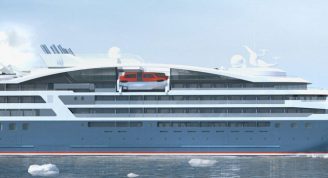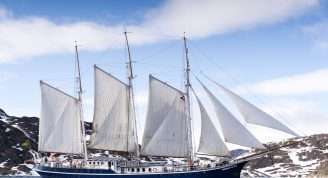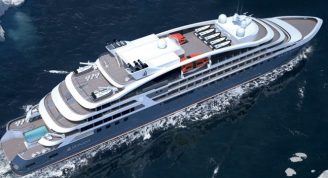Description
Embark on an Arctic expedition that gives you the stunning ice-filled scenery of Spitsbergen’s late winter combined with the enhanced wildlife possibilities of the budding spring.
Trip Name
North Spitsbergen, Arctic Spring
Days
11
Overview
Vessel Type: Expedition Yacht
Length: 49.5 metres
Passenger Capacity: 33
Built / refurbished: 1900's / 1994 / 2011
S/V ‘Rembrandt Van Rijn’ was built as a herring lugger early last century. The vessel was rebuilt as a three-mast passenger sailing schooner in he Netherlands in 1994 and sailed in Spitsbergen (1994 – 1996) and in Galápagos (1998 - 2001). The vessel underwent a complete rebuilding and refurbishment program until 2011. The communication and navigation equipment has been completely renewed according to the latest SOLAS regulations.
The ship is well suited for expedition cruising among small islands and offer good open deck viewing areas, also when under sail. The 2 inflatable rubber crafts (zodiacs) enable landing and wildlife viewing opportunities in otherwise inaccessible areas.
The Rembrandt van Rijn measures 49,50 meters in length, 7 meters in width and has a draft of 2,8 meters. The average cruising speed on engines is 6,5 knots. It has an experienced crew of 12 persons on board including 2 tour guides. The ship can accommodate a maximum of 33 passengers in 16 cabins. 1 Triple Private cabin (with shower and toilet and porthole), 6 Twin Private Inside cabins (with shower and toilet, no porthole), 9 Twin Private cabins (with shower and toilet and porthole).
S/V ‘Rembrandt Van Rijn’ was built as a herring lugger early last century. The vessel was rebuilt as a three-mast passenger sailing schooner in he Netherlands in 1994 and sailed in Spitsbergen (1994 – 1996) and in Galápagos (1998 - 2001). The vessel underwent a complete rebuilding and refurbishment program until 2011. The communication and navigation equipment has been completely renewed according to the latest SOLAS regulations.
Perfect for expedition cruising among small islands
The ship is well suited for expedition cruising among small islands and offer good open deck viewing areas, also when under sail. The 2 inflatable rubber crafts (zodiacs) enable landing and wildlife viewing opportunities in otherwise inaccessible areas. The Rembrandt van Rijn measures 56 meters in length (168 ft.), 7 meters in width and has a draft of 2,5 meters. The maximum speed on engines is 9 knots. It has an experienced crew of 12 persons on board including 2 tour guides. The ship can accommodate a maximum of 33 passengers in 16 twin cabins in 1 Triple Private cabin (with shower and toilet and porthole), 6 Twin Private Inside cabins (with shower and toilet, no porthole), 9 Twin Private cabins (with shower and toilet and porthole).
Comfort and Character
The Rembrandt van Rijn measures 56 meters in length (168 ft.), 7 meters in width and has a draft of 2,5 meters. The maximum speed on engines is 9 knots. It has an experienced crew of 12 persons on board including 2 tour guides. The ship can accommodate a maximum of 33 passengers in 16 twin cabins in 1 Triple Private cabin (with shower and toilet and porthole), 6 Twin Private Inside cabins (with shower and toilet, no porthole), 9 Twin Private cabins (with shower and toilet and porthole).
- See more at: http://www.oceanwide-expeditions.com/our-fleet/ship/s-v-rembrandt-van-rijn/#sthash.IBRETHkk.dpuf
History
S/V ‘Rembrandt Van Rijn’ was built as a herring lugger early last century. The vessel was rebuilt as a three-mast passenger sailing schooner in he Netherlands in 1994 and sailed in Spitsbergen (1994 – 1996) and in Galápagos (1998 - 2001). The vessel underwent a complete rebuilding and refurbishment program until 2011. The communication and navigation equipment has been completely renewed according to the latest SOLAS regulations.
Perfect for expedition cruising among small islands
The ship is well suited for expedition cruising among small islands and offer good open deck viewing areas, also when under sail. The 2 inflatable rubber crafts (zodiacs) enable landing and wildlife viewing opportunities in otherwise inaccessible areas. The Rembrandt van Rijn measures 56 meters in length (168 ft.), 7 meters in width and has a draft of 2,5 meters. The maximum speed on engines is 9 knots. It has an experienced crew of 12 persons on board including 2 tour guides. The ship can accommodate a maximum of 33 passengers in 16 twin cabins in 1 Triple Private cabin (with shower and toilet and porthole), 6 Twin Private Inside cabins (with shower and toilet, no porthole), 9 Twin Private cabins (with shower and toilet and porthole).
Comfort and Character
The Rembrandt van Rijn measures 56 meters in length (168 ft.), 7 meters in width and has a draft of 2,5 meters. The maximum speed on engines is 9 knots. It has an experienced crew of 12 persons on board including 2 tour guides. The ship can accommodate a maximum of 33 passengers in 16 twin cabins in 1 Triple Private cabin (with shower and toilet and porthole), 6 Twin Private Inside cabins (with shower and toilet, no porthole), 9 Twin Private cabins (with shower and toilet and porthole).
- See more at: http://www.oceanwide-expeditions.com/our-fleet/ship/s-v-rembrandt-van-rijn/#sthash.IBRETHkk.dpuf
S/V ‘Rembrandt Van Rijn’ was built as a herring lugger early last century. The vessel was rebuilt as a three-mast passenger sailing schooner in he Netherlands in 1994 and sailed in Spitsbergen (1994 – 1996) and in Galápagos (1998 - 2001). The vessel underwent a complete rebuilding and refurbishment program until 2011. The communication and navigation equipment has been completely renewed according to the latest SOLAS regulations. - See more at: http://www.oceanwide-expeditions.com/our-fleet/ship/s-v-rembrandt-van-rijn/#sthash.IBRETHkk.dpuf
History
S/V ‘Rembrandt Van Rijn’ was built as a herring lugger early last century. The vessel was rebuilt as a three-mast passenger sailing schooner in he Netherlands in 1994 and sailed in Spitsbergen (1994 – 1996) and in Galápagos (1998 - 2001). The vessel underwent a complete rebuilding and refurbishment program until 2011. The communication and navigation equipment has been completely renewed according to the latest SOLAS regulations.
Perfect for expedition cruising among small islands
The ship is well suited for expedition cruising among small islands and offer good open deck viewing areas, also when under sail. The 2 inflatable rubber crafts (zodiacs) enable landing and wildlife viewing opportunities in otherwise inaccessible areas. The Rembrandt van Rijn measures 56 meters in length (168 ft.), 7 meters in width and has a draft of 2,5 meters. The maximum speed on engines is 9 knots. It has an experienced crew of 12 persons on board including 2 tour guides. The ship can accommodate a maximum of 33 passengers in 16 twin cabins in 1 Triple Private cabin (with shower and toilet and porthole), 6 Twin Private Inside cabins (with shower and toilet, no porthole), 9 Twin Private cabins (with shower and toilet and porthole).
Comfort and Character
The Rembrandt van Rijn measures 56 meters in length (168 ft.), 7 meters in width and has a draft of 2,5 meters. The maximum speed on engines is 9 knots. It has an experienced crew of 12 persons on board including 2 tour guides. The ship can accommodate a maximum of 33 passengers in 16 twin cabins in 1 Triple Private cabin (with shower and toilet and porthole), 6 Twin Private Inside cabins (with shower and toilet, no porthole), 9 Twin Private cabins (with shower and toilet and porthole).
- See more at: http://www.oceanwide-expeditions.com/our-fleet/ship/s-v-rembrandt-van-rijn/#sthash.IBRETHkk.dpuf


